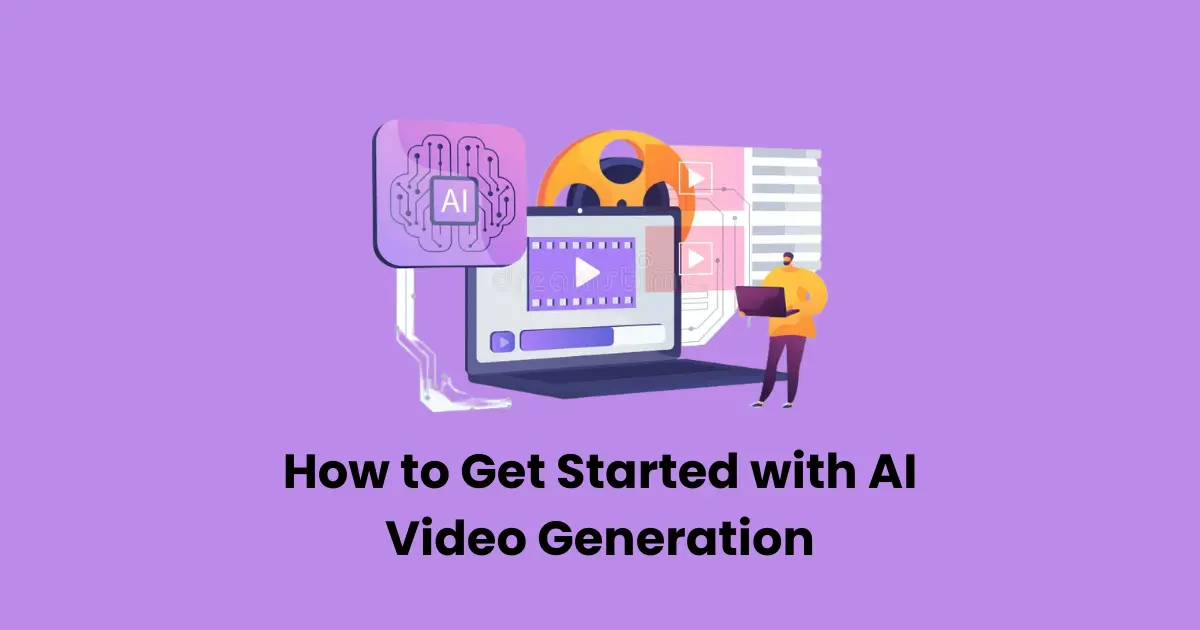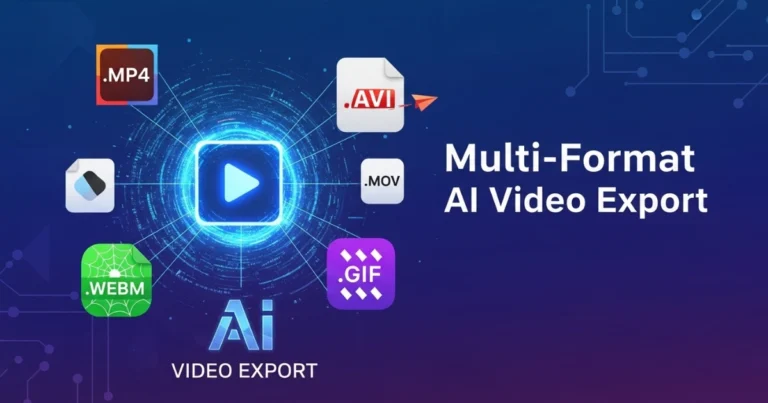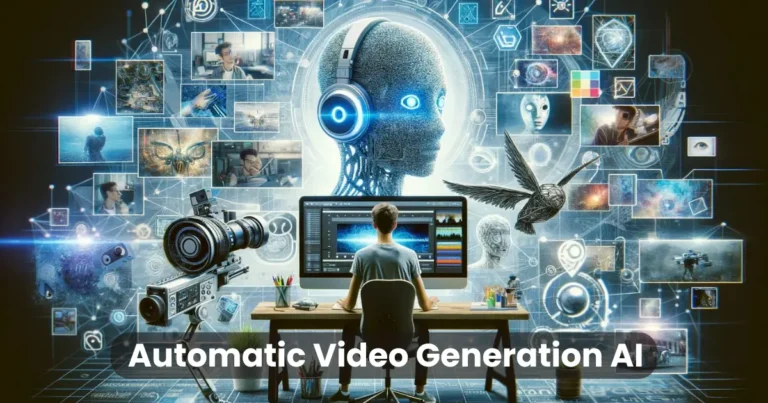How to Get Started with AI Video Generation

Contents
- 1 What is AI Video Generation?
- 2 Benefits of Using AI for Video Creation
- 3 Prerequisites Before You Begin
- 4 Step-by-Step Guide to Get Started
- 5 Best AI Video Tools in 2025
- 6 Common Mistakes to Avoid
- 7 Tips for Better AI-Generated Videos
- 7.1 1. Start With a Strong Hook
- 7.2 2. Use Clear and Concise Language
- 7.3 3. Match Voice and Avatar to Your Brand
- 7.4 4. Keep Visuals Minimal but Purposeful
- 7.5 5. Incorporate Background Music Wisely
- 7.6 6. Use Branding Strategically
- 7.7 7. Optimize for SEO and Accessibility
- 7.8 8. Test Different Versions
- 7.9 Conclusion
In today’s digital era, how to get started with AI video generation has become a frequently asked question among marketers, content creators, and educators. People widely use AI-generated videos to save time, reduce costs, and simplify production processes. For those new to this technology, the journey may appear complex. However, by following a structured approach, anyone can begin creating high-quality videos powered by artificial intelligence.
User-friendly tools have significantly reduced the learning curve, allowing creators to produce video content at scale through automation. Moreover, professionals across multiple industries have embraced AI video generation, making it an essential skill in today’s content-driven world. This guide will walk you through everything from choosing the right software to finalizing your AI video—all while optimizing for efficiency and creativity.
What is AI Video Generation?
AI video generation refers to the process of creating video content using artificial intelligence technologies that automate various production steps. Instead of filming actors or manually editing scenes, creators now use AI software to synthesize visuals, voiceovers, animations, and even entire characters. As a result, they can create videos with minimal effort—often in just a few clicks.
At its core, AI video generation relies on machine learning algorithms and natural language processing. AI voices can turn scripts into spoken dialogue, while avatars or digital humans act out scenes based on textual input. Additionally, the system automatically generates stock footage, animations, transitions, and subtitles based on the video’s context.
Businesses, educators, influencers, and even filmmakers are adopting this method rapidly. For example, they now use AI tools to produce explainer videos, e-learning modules, marketing reels, and social media content—without any prior editing or filming experience. Most importantly, learning how to get started with AI video generation has become easier than ever, thanks to intuitive platforms like Synthesia, Pictory, and Lumen5.
Benefits of Using AI for Video Creation
AI video creation offers numerous advantages that make it an appealing solution for individuals and businesses alike. Once the initial setup has been completed, the entire video production process can be streamlined, saving both time and resources. Below are the key benefits of using AI for video content:

1. Faster Production Times
Traditional video editing often takes hours—or even days—for scripting, recording, and post-production. In contrast, creators can use AI to generate videos in minutes. In fact, they can quickly create multiple versions of the same video by simply adjusting the text input.
2. Cost-Effective Solution
Hiring actors, editors, and videographers can be expensive. On the other hand, AI video tools often come with a subscription model that dramatically reduces costs. For startups and solo creators, this is especially beneficial.
3. No Technical Expertise Needed
Even users without a background in video editing or graphic design can easily produce professional-looking content. Most AI video platforms offer drag-and-drop interfaces, templates, and automated voiceovers, helping new users easily understand how to get started with AI video generation.
4. Multilingual Support
Many AI video generators support automatic translation and voice synthesis in dozens of languages. This allows global content distribution without the need for multiple voice actors or translators.
5. Scalability
Because AI automates video creation, businesses can scale it across campaigns, training programs, and product launches. They can quickly replicate and customize content for different audiences.
6. Consistency in Branding
AI tools allow you to save templates, fonts, colors, and avatars, ensuring that every video aligns with your brand guidelines. This eliminates inconsistencies that often occur in manual editing processes.
These benefits explain why more professionals are exploring AI video generation and integrating it into their content strategy.
Prerequisites Before You Begin
Before diving into the process of creating videos with AI, you should prepare a few essential elements to ensure a smooth start. With the right resources and mindset in place, you’ll minimize the learning curve and enhance productivity.

1. Clear Objective and Audience
A clear goal must be established before video creation begins. Whether the content is educational, promotional, or for internal training, understanding your target audience will influence the tone, visuals, and script.
2. Basic Script or Text Input
While some AI tools generate scripts based on prompts, it is still recommended that a rough draft of your script be written in advance. This will guide the narration and structure of your video.
3. Reliable Internet Connection
Most AI video platforms are cloud-based, so you need a stable and fast internet connection for smooth operation, especially during rendering and uploading stages.
4. Account on an AI Video Platform
A user account must be created on a reputable AI video generation platform. Popular choices include:
- Synthesia (for talking avatars)
- Pictory (for converting blog text to video)
- Lumen5 (for social media videos)
5. Branding Assets (Optional)
Logos, brand colors, and fonts should be uploaded if you want your videos to remain consistent with your brand identity. Most AI platforms allow custom branding.
6. Headphones and Microphone (If Needed)
While AI voiceovers are an option, using a microphone is helpful if you prefer a personal voice recording. In this case, headphones will make editing more efficient.
Following these basic steps will prepare you to move forward with AI video generation, giving you a head start before using any platform.
Step-by-Step Guide to Get Started
Getting started with AI video generation involves following a structured process that ensures smooth video creation, even for beginners. Each step below builds upon the previous one, guiding you from idea to finished product. Although AI handles much of the heavy lifting, your input will still shape the final video’s quality and purpose.

1 Choose the Right AI Video Tool
First, a platform must be selected based on your needs. For example:
- Synthesia – Best for avatar-based narration
- Pictory – Ideal for turning blog posts into videos
- Lumen5 – Designed for social media marketing
- DeepBrain – Great for realistic virtual presenters
When evaluating tools, you should carefully consider features like avatar variety, text-to-speech quality, export options, and pricing plans.
2 Write or Upload a Script
Next, a script should be written or uploaded into the platform. Most AI tools allow users to paste or import text, which will then be read aloud by an AI voice. A clear and concise script will improve pacing and viewer understanding. For multilingual audiences, built-in translation features can also be activated.
3 Select an Avatar or Visual Style
After the script is in place, a virtual presenter or design theme can be selected. This visual representation acts as the face of your video. Most tools provide customizable avatars, stock footage, or animated elements to enhance your storytelling.
4 Customize the Voice and Background
Then, voice and background choices can be configured. Voice settings typically include:
- Gender
- Accent
- Language
- Tone
Backgrounds can range from static colors to animated settings, or even uploaded custom images for branded content.
5 Generate and Edit the Video
Once all settings are finalized, the video should be generated. This may take anywhere from a few seconds to a few minutes, depending on the platform and video length.
After rendering, minor edits can be made to timing, text placement, or background elements. When satisfied, the video can be downloaded or shared directly.
By completing these steps, you’ll fully understand how to get started with AI video generation and produce content efficiently and confidently.
Best AI Video Tools in 2025
To truly master how to get started with AI video generation, selecting the right platform is critical. As of 2025, several AI video tools stand out for their usability, features, and innovation. Each offers unique advantages depending on the user’s goals—whether creating explainer videos, marketing reels, or training content.

Here are the top AI video generation tools in 2025:
1. Synthesia
- Best for: Avatar-based videos and corporate training
- Key Features: 120+ AI avatars, 130+ languages, automatic subtitles, easy brand customization
- Pros: Realistic virtual presenters and excellent multilingual support
- Cons: Limited customization beyond templates
2. Pictory
- Best for: Turning blog posts and long-form content into short videos
- Key Features: Text summarization, voiceover sync, auto-captioning
- Pros: Fast conversion from scripts to videos, especially great for repurposing blog content
- Cons: Limited avatar options
3. Lumen5
- Best for: Social media content creation
- Key Features: Templates for Instagram, TikTok, YouTube, and LinkedIn
- Pros: Easy drag-and-drop editor, AI-powered script-to-video function
- Cons: Less suitable for professional training or narration-heavy content
4. DeepBrain AI
- Best for: Hyper-realistic AI presenters
- Key Features: Custom avatar creation, studio-quality visuals
- Pros: High-end visual quality for news, education, and business
- Cons: More expensive and best suited for enterprise-level users
5. VEED.io
- Best for: All-in-one editing and AI voiceover features
- Key Features: Screen recording, video editing, subtitles, AI avatars
- Pros: Versatile platform for creators who want more manual control
- Cons: Steeper learning curve for beginners
6. HeyGen (formerly Movio)
- Best for: Startups and quick product videos
- Key Features: Text-to-video with avatars, integrations with CRMs and tools
- Pros: Affordable, fast, and easy to use
- Cons: Fewer avatar options than premium tools
Each of these tools reduces production time and simplifies getting started with AI video generation, whether you’re creating one video a month or a hundred per week.
Common Mistakes to Avoid
While learning how to get started with AI video generation, many users—especially beginners—can fall into avoidable traps. These mistakes often lead to poor video quality, viewer disengagement, or wasted resources. Fortunately, by recognizing these issues in advance, they can be easily prevented.
Here are the most common pitfalls:
1. Overloading the Script with Information
Including too much detail in one video may overwhelm viewers. AI-generated videos work best when focused on a single message. Create several shorter clips instead of one long video to improve clarity and engagement.
2. Using Robotic or Monotone AI Voices
Many platforms offer multiple AI voice styles, accents, and emotions. If you select a default or unnatural-sounding voice, viewers may lose interest. Match the voice to the tone of the message—use a friendly voice for product demos or a calm tone for tutorials.
3. Ignoring Visual Consistency
Using mismatched visuals, backgrounds, or text formatting can confuse viewers. Templates and brand colors should be applied consistently. Additionally, slides should not switch too fast or include distracting transitions.
4. Failing to Optimize for the Platform
Each platform—whether YouTube, Instagram, or a company website—has unique video size, length, and format requirements. If not optimized, AI videos may appear cropped, blurry, or poorly timed.
5. Neglecting to Add Subtitles or Captions
Many viewers watch videos on mute, especially on mobile. If you don’t add subtitles, large audiences may miss your message. Always enable the auto-captioning feature offered by most AI video tools.
6. Skipping a Final Review
Even with automation, mistakes can still happen. Correct typos, poor transitions, or mispronounced words before publishing. Always watch a preview and revise as needed.
By avoiding these mistakes, you’ll make your first experience more successful and turn getting started with AI video generation into an enjoyable, repeatable process.
Tips for Better AI-Generated Videos
Once you understand the basics of how to get started with AI video generation, your next goal is to elevate your content. Although AI simplifies the technical process, creativity and strategy still play a key role in producing engaging, professional-looking videos.

Here are expert tips to help you improve the quality and impact of your AI-generated videos:
1. Start With a Strong Hook
The first few seconds are critical. Start with a compelling question, bold statement, or eye-catching animation to immediately grab attention.
2. Use Clear and Concise Language
AI-generated videos work best with simple, easy-to-understand phrasing. Avoid long, complex sentences. Deliver your message quickly and clearly to maintain viewer engagement.
3. Match Voice and Avatar to Your Brand
Many tools offer different AI voices and avatars—choose one that reflects your brand’s personality. A corporate tone may require a formal avatar, while a lifestyle brand might do better with a friendly, casual look and sound.
4. Keep Visuals Minimal but Purposeful
Every visual element should support the message. Avoid excessive text, animations, or background changes. Instead, embrace minimalism to highlight the most important points.
5. Incorporate Background Music Wisely
Light background music can add polish, but it should not distract from the narration. Choose royalty-free tracks that align with your content’s mood—energetic for promotions, calm for explanations.
6. Use Branding Strategically
Logo placement, colors, and fonts must be consistent across all videos. Branding helps build recognition and trust—especially important for social media and marketing content.
7. Optimize for SEO and Accessibility
Include relevant keywords—such as how to get started with AI video generation—in your video titles, file names, descriptions, and subtitles. Not only does this improve search engine rankings, but it also ensures accessibility.
8. Test Different Versions
Run short A/B testing campaigns to compare different voiceovers, visual layouts, or calls to action. Over time, you’ll gain insights into what resonates most with your audience.
By applying these tips, AI-generated videos will not only be easier to produce—they’ll also look more professional and drive better engagement.
Conclusion
As this guide has shown, learning how to get started with AI video generation offers an accessible and efficient way to produce professional-quality videos—without needing a camera crew, actors, or expensive editing software.
The process has been simplified through intuitive tools, customizable avatars, and AI voiceovers, making it ideal for businesses, educators, marketers, and content creators alike. With just a script and a few clicks, you can produce engaging videos in minutes rather than days. Additionally, you can avoid common mistakes and apply powerful tips to create content that’s both polished and impactful.
Whether your goal is to explain a product, deliver training, or boost your online presence, AI video generation provides a scalable solution. While human creativity remains essential for crafting the message, AI handles the technical execution—allowing you to focus on storytelling.
If you’re wondering how to get started with AI video generation, the answer is simple: choose your tool, craft your script, and let AI bring your vision to life.






